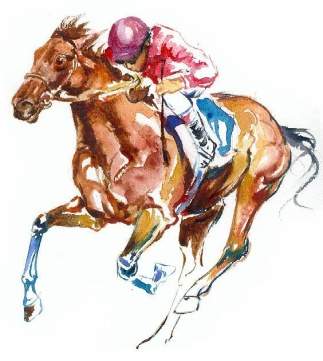
Horse Racing
Are you curious to learn everything about horse racing? pickdaponies.com is specialized in horse racing and horse racing picks.
Horse Racing
Horse racing is an equestrian sport that has a long history. Archaeological records indicate that horse racing occurred in ancient Greece, Babylon, Syria, and Egypt.[1] Both chariot and mounted horse racing were events in the ancient Greek Olympics by 648 BC.[2] In the Roman Empire, chariot and mounted horse racing were major industries.[3] Thoroughbred racing was, and is, popular with the aristocrats and royalty of British society, earning it the title "Sport of Kings."[4] The style of racing, the distances and the type of events vary significantly by the country in which the race is occurring, and many countries offer different types of horse races. There are three major types of racing: flat racing, steeplechasing (racing over jumps), and harness racing, where horses trot or pace while pulling a driver in a sulky.[5] A major part of horse racing's economic importance lies in the gambling associated with it,[6] an activity that in 2008 generated a world-wide market worth around US$115 billion.[7] Various types of racing have given rise to horse breeds that excel in the specific disciplines of each sport. Breeds that may be used for flat racing include the Thoroughbred, Quarter Horse, Arabian, Paint, and Appaloosa.[8] Steeplechasing breeds include the Thoroughbred and AQPS. Harness racing is dominated by Standardbred horses in Australia, New Zealand and North America, but several other breeds, such as the Russian Trotter and Finnhorse, are seen in Europe..
History Historically, equestrians honed their skills through games and races. Equestrian sports provided entertainment for crowds and honed the excellent horsemanship that was needed in battle. Horse racing of all types evolved from impromptu competitions between riders or drivers. All forms of competition, requiring demanding and specialized skills from both horse and rider, resulted in the systematic development of specialized breeds and equipment for each sport.[9] Riderless Racers at Rome by Théodore Géricault. From the mid-15th century until 1882, spring carnival in Rome closed with a horse race. Fifteen to 20 riderless horses, originally imported from the Barbary Coast of North Africa, ran the length of the Via del Corso, a long, straight city street, in about 2½ minutes. Chariot racing was one of the most popular ancient Greek, Roman and Byzantine sports. Chariot racing was often dangerous to both driver and horse as they frequently suffered serious injury and even death, but generated strong spectator enthusiasm. In the ancient Olympic Games, as well as the other Panhellenic Games, the sport was one of the most important equestrian events. Horse racing was also a part of myth and legend, such as the contest between the steeds of the god Odin and the giant Hrungnir in Norse mythology. The popularity of equestrian sports through the centuries has resulted in the preservation of skills that would otherwise have disappeared after horses stopped being used in combat.
Thoroughbred
There are three founding sires that almost all Thoroughbreds can trace back to: the Darley Arabian, the Godolphin, and the Byerly Turk, named after their respective owners, Thomas Darley, Lord Godolphin, and Captain Robert Byerly.[10] All were taken to England where they were mated with racing mares. Thoroughbreds range in height, and are measured in hands (a hand being four inches). Some are as small as 15 hands while others are over 17 hands. Thoroughbreds can travel medium distances at fast paces, requiring a balance between speed and endurance.
Thoroughbred racing
Flat racing is the most common form of Thoroughbred racing. The track is typically oval in shape and the race is based on speed and stamina. Within the general category of Thoroughbred flat racing, there exist two separate types of races. These include conditions races and handicap races. Condition races are the most prestigious and offer the biggest purses. Handicap races assign each horse a different amount of weight to carry based on their ability.[11] Beside the weight they carry, the horse is also influenced by its closeness to the inside barrier, the track surface, its gender, the jockey, and the trainer. A typical Thoroughbred race is run on dirt, synthetic or turf surfaces. Viscoride and Polytrack are synthetic substitutes. Thoroughbred races vary in distance, but are usually somewhere between five and twelve furlongs. A furlong is a distance measurement equal to one eighth of a mile, 220 yards[12] or 201.168 metres.
Training
The conditioning program for the different horses varies depending on the race length. Genetics, training, age, and skeletal soundness are all factors that contribute to a horse’s performance.[13] The muscle structure and fiber type of horses depends on the breed, therefore genetics must be considered when constructing a conditioning plan. A horse’s fitness plan must be coordinated properly in order to prevent injury or unnecessary lameness. If these were to occur, they may negatively affect a horse’s willingness to learn.[13] Sprinting exercises are appropriate for training two-year-old racehorses, but they are mentally incapable of handling too many of them.[13] A horse’s skeletal system adapts to the exercise they are receiving. Because the skeletal system does not reach full maturity until the horse is at least four years of age, young racehorses often suffer multiple injuries.[13]